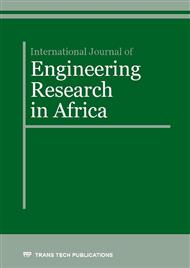[1]
N. Gorjian, L. Ma, M. Mittinty, P. Yarlagadda, and Y. Sun, A review on reliability models with covariates, in Engineering Asset Lifecycle Management, Springer, 2010, p.385–397.
DOI: 10.1007/978-0-85729-320-6_43
Google Scholar
[2]
D. R. Cox, Regression Models and Life-Tables, J. R. Stat. Soc. Ser. B, vol. 34, no. 2, p.187–220, (1972).
Google Scholar
[3]
O. Basile, P. Dehombreux, and F. Riane, Identification of reliability models for non repairable and repairable systems with small samples, in Proceedings of IMS2004 Conference on Advances in maintenance and modeling, simulation and intelligent monitoring of degradation, Arles, 2004, p.1.
Google Scholar
[4]
S. -T. Jiang, T. L. Landers, and T. R. Rhoads, Assessment of repairable-system reliability using proportional intensity models: A review, Reliab. IEEE Trans., vol. 55, no. 2, p.328–336, (2006).
DOI: 10.1109/tr.2006.874938
Google Scholar
[5]
L. Mifdal, Z. Hajej, and S. Dellagi, Joint optimization approach of maintenance and production planning for a multiple-product manufacturing system, Math. Probl. Eng., vol. 2015, (2015).
DOI: 10.1155/2015/769723
Google Scholar
[6]
Y. Fuqing and U. Kumar, Proportional Intensity Model considering Imperfect Repair for Repairable Systems, Int. J. Performability Eng., vol. 9, no. 2, p.163–174, (2013).
Google Scholar
[7]
F. Q. Yuan and J. M. Lu, Imperfect repair model for complex repairable system-a literature survey with discussion, in Industrial Engineering and Engineering Management (IEEM), 2015 IEEE International Conference on, 2015, p.807–811.
DOI: 10.1109/ieem.2015.7385759
Google Scholar
[8]
R. Guo, H. Ascher, and C. E. Love, Generalized models of repairable systems a survey via stochastic processes formalism, ORiON, vol. 16, no. 2, p.87–128, (2000).
DOI: 10.5784/16-2-406
Google Scholar
[9]
H. Pham and H. Wang, Imperfect maintenance, Eur. J. Oper. Res., (1996).
Google Scholar
[10]
M. Kijima, Some results for repairable systems with general repair, J. Appl. Probab., (1989).
Google Scholar
[11]
I. Shin, T. Lim, and C. Lie, Estimating parameters of intensity function and maintenance effect for repairable unit, Reliab. Eng. Syst. Saf., (1996).
Google Scholar
[12]
L. Wang, H. Hu, Y. Wang, W. Wu, and P. He, The availability model and parameters estimation method for the delay time model with imperfect maintenance at inspection, Appl. Math. Model., (2011).
DOI: 10.1016/j.apm.2010.11.070
Google Scholar
[13]
S. Taghipour and D. Banjevic, Periodic inspection optimization models for a repairable system subject to hidden failures, Reliab. IEEE Trans., vol. 60, no. 1, p.275–285, (2011).
DOI: 10.1109/tr.2010.2103596
Google Scholar
[14]
A. H. Christer, Developments in delay time analysis for modelling plant maintenance, J. Oper. Res. Soc., p.1120–1137, (1999).
Google Scholar
[15]
W. Wang, An overview of the recent advances in delay-time-based maintenance modelling, Reliab. Eng. Syst. Saf., vol. 106, p.165–178, (2012).
Google Scholar
[16]
A. J. MacPherson and K. D. Glazebrook, How and when to deploy error prone sensors in support of the maintenance of two-phase systems with ageing, Reliab. IEEE Trans., vol. 63, no. 1, p.118–133, (2014).
DOI: 10.1109/tr.2014.2299638
Google Scholar
[17]
R. Lopes, C. Cavalcante, and M. Alencar, Delay-time inspection model with dimensioning maintenance teams: A study of a company leasing construction equipment, Comput. Ind., (2015).
DOI: 10.1016/j.cie.2015.07.009
Google Scholar
[18]
A. H. Christer and D. F. Redmond, A recent mathematical development in maintenance theory, IMA J. Manag. Math., vol. 2, no. 2, p.97–108, (1989).
DOI: 10.1093/imaman/2.2.97
Google Scholar
[19]
R. D. Baker and W. Wang, Estimating the delay-time distribution of faults in repairable machinery from failure data, IMA J. Manag. Math., vol. 3, no. 4, p.259–281, (1991).
DOI: 10.1093/imaman/3.4.259
Google Scholar
[20]
D. Wang, L. Wen, and X. S. Jia, Maximum likelihood estimation of delay time mode, J. Ordnance Eng. Coll., vol. 17, no. 3, p.33–35, (2005).
Google Scholar
[21]
H. Hu, G. Cheng, Q. Duan, W. Wu, and C. Xu, Delay time model based on imperfect maintenance, " J. Xi, an Jiaotong Univ., vol. 43, no. 6, p.103–107, (2009).
Google Scholar
[22]
E. Nazemi and K. Shahanaghi, Developing an Inspection Optimization Model Based on the Delay-Time Concept, J. Ind. Eng., (2015).
Google Scholar
[23]
W. Wang, A joint spare part and maintenance inspection optimisation model using the Delay-Time concept, Reliab. Eng. Syst. Saf., (2011).
Google Scholar
[24]
A. O. Olumuyiwa, A decision support model to improve rolling stock maintenance scheduling based on reliability and cost., Stellenbosch University, (2014).
Google Scholar
[25]
C. McCollin, Intensity functions for nonhomogeneous Poisson processes, Encycl. Stat. Qual. Reliab., (2007).
Google Scholar
[26]
R. Jiang, Reliability Modeling of Repairable Systems, in Introduction to Quality and Reliability Engineering, Springer, 2015, p.89–109.
DOI: 10.1007/978-3-662-47215-6_6
Google Scholar
[27]
D. M. Louit, R. Pascual, and A. K. S. Jardine, A practical procedure for the selection of time-to-failure models based on the assessment of trends in maintenance data, Reliab. Eng. Syst. Saf., vol. 94, no. 10, p.1618–1628, (2009).
DOI: 10.1016/j.ress.2009.04.001
Google Scholar
[28]
S. Taghipour, D. Banjevic, and A. K. S. Jardine, Reliability analysis of maintenance data for complex medical devices, Qual. Reliab. Eng. Int., vol. 27, no. 1, p.71–84, (2011).
DOI: 10.1002/qre.1084
Google Scholar
[29]
B. Lindqvist, On the statistical modeling and analysis of repairable systems, Stat. Sci., (2006).
Google Scholar
[30]
K. Muralidharan, A review of repairable systems and point process models, in ProbStat Forum, 2010, vol. 1, p.26–49.
Google Scholar
[31]
Y. Tang, J. J. Jing, Y. Yang, and C. Xie, Parameter Estimation of a Delay Time Model of Wearing Parts Based on Objective Data, Math. Probl. Eng., vol. 2015, (2015).
DOI: 10.1155/2015/419280
Google Scholar
[32]
A. Christer, W. Wang, K. Choi, and J. Sharp, The delay-time modelling of preventive maintenance of plant given limited PM data and selective repair at PM, IMA J. Manag., (1998).
DOI: 10.1093/imaman/9.4.355
Google Scholar
[33]
H. Mahfoud, A. El Barkany, and A. El Biyaali, Etude des stratégies de maintenance biomédicale: Situation actuelle et perspectives, in Xème Conférence Internationale: Conception et Production Intégrées, (2015).
Google Scholar
[34]
H. Mahfoud, A. El Barkany, and A. El Biyaali, A Hybrid Decision-Making Model for Maintenance Prioritization in Health Care Systems, Am. J. Appl. Sci., vol. 13, no. 4, p.439. 450, (2016).
DOI: 10.3844/ajassp.2016.439.450
Google Scholar


